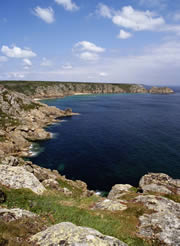Coastline carve thyselfTheory accounts for land's fractal
fringes.
26 November
2003
PHILIP
BALL
 |
| Rocky coasts are natural
fractals. |
| ©
GettyImages | | |
The beauty of jagged, rocky coastlines will prevail,
however hard the sea pounds them. The classic coastal
profile is a balance between the sea's eroding power and
the ability of the coastline to damp it out, say
researchers in France and Italy.
Although a coast continues to crumble and break up
under the relentless assault of the waves, it soon
adopts a pitted, fractal form that modifies the force
that erodes it. "Whatever its initial shape, a rocky
shore will end up fractal," the researchers
conclude.
When the science of fractals emerged in the 1960s,
the ordered complexity of coastlines quickly made them
the best example in the natural world. A fractal pattern
repeats over and over at different scales of
magnification - so that a one-kilometre stretch of coast
looks as rugged as a 100-kilometre one.
But there has never been an explanation for why
coastlines are fractal, says Bernard Sapoval of the
Ecole Polytechnique in Palaiseau, France.
Until now, that is. "Fractal coastlines are best at
damping waves," Sapoval explains. "As the coast damps
down the waves, the erosion to which it is subjected is
reduced."
To test the idea, Sapoval and his colleagues built a
computer model of coastal erosion. Material in the model
is removed from the coastline either by fast 'quarrying'
by waves, or by slow 'weathering', where minerals
dissolve in water.
In the model the coastline is divided into a grid.
The rock type - and thus the resistance to weathering
erosion - varies from one grid cell to another at
random.
The erosive power of the sea depends on how heavily
damped the waves are. They will be calmer in a narrow
bay or inlet, for example. Sapoval and colleagues
assumed that this damping increases as the coast becomes
more pitted.
|
Fractal coastlines are best at
damping waves |
|
Bernard Sapoval
Ecole
Polytechnique,
Palaiseau | | |
Running the model, the researchers found that an
initially smooth coastline rapidly breaks up into a
rough-edged profile with many offshore islands.
Eventually it settles down into a realistic-looking
profile with a fractal shape1.
Their modelled coast was similar to the real US East
Coast.
The model neglects some processes that are known to
be important in shaping some coasts, such as sediment
transport by rivers. But the researchers think that the
basic process they have identified - modification of
erosion force by the coast itself - plays a central role
in carving out coastlines. | 
